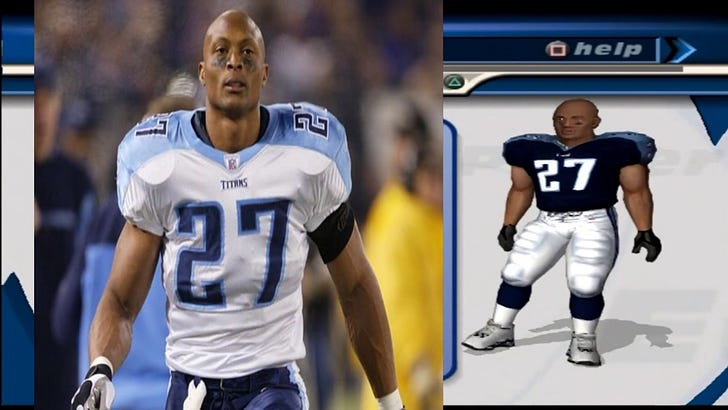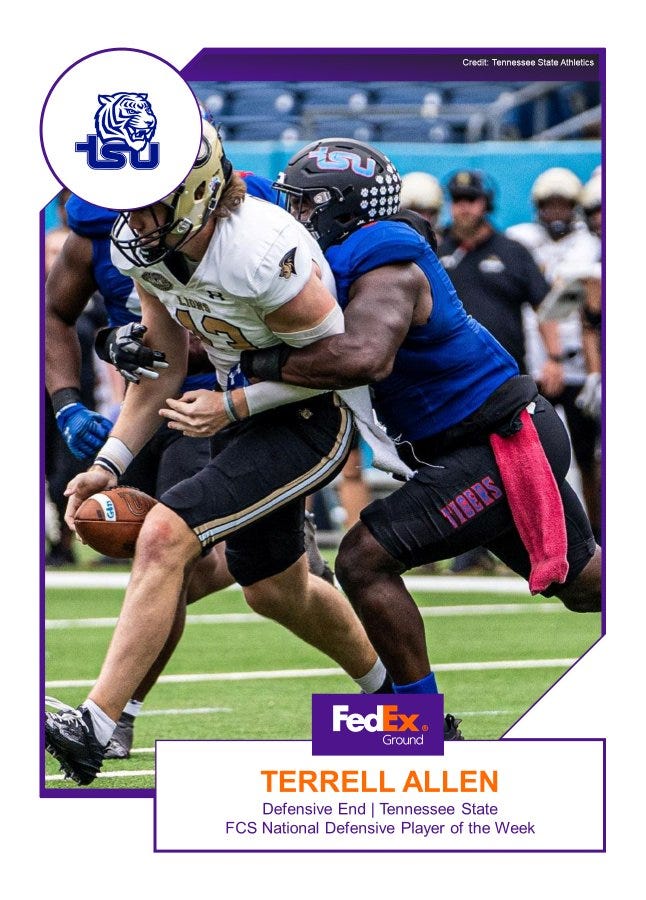Few football coaches ever won the Heisman Trophy. Even fewer graced the cover of Madden.
Eddie George accomplished both. With less than a month remaining in the 2023 Football Championship Subdivision regular season, George has another major milestone within reach in his third year as a Div. I head coach.
Tennessee State’s 43-20 rout of Lindenwood — which was considerably more lopsided than the final score indicates; the Lions scored 13 fourth-quarter points against the TSU reserves — improved the Tigers to 6-2. They’ve rolled up four straight wins, including a 27-20 of a Kennesaw State program preparing to transition to FBS.
Coupled with UT Martin’s loss at Gardner-Webb, Tennessee State is now tied atop the loss of the Big South-OVC alliance with UTM, and in the win column with Southeast Missouri State.
TSU needs some breaks to make the FCS Playoffs with UTM holding the tiebreaker, the result of the Skyhawks winning head-to-head in the first month of the season. It’s the Tigers’ only setback against an FCS opponent, the other defeat coming Week 1 at Notre Dame.
Whether Tennessee State earns the Big South-OVC automatic bid, though, 2023 is a successful season for the Tigers — especially if they win out and get to nine wins for the first time since 2013, which was also the last playoff appearance in the program’s history.
And TSU football history is illustrious. Under Hall of Fame coach John Merritt, the Tigers went undefeated four times from 1965 through 1973 in the old NCAA College Division. The last squad in that run in 1973 was the only HBCU to win an outright College Division national championship, a title also claimed in its 17-season history by North Dakota State, Arkansas State Northern Illinois, San Diego State and Southern Miss.
Once the NCAA created Div. I subdivisions in the late ‘70s, Tennessee State successfully transitioned with playoff appearances in both 1981 and 1982.
Merritt claimed seven of his eight career Black National Championships at TSU, the other at Jackson State. His last came in 1982, one year before his death at just 57 due to an heart ailment.
That’s all to say Tennessee State boasts one of the most impressive lineages of any HBCU program, but also fell on some hard times.
In 1999, the same year George powered a Tennessee Titans offense that reached the Super Bowl, the Tigers won the Ohio Valley Conference championship. The ensuing playoff appearance was TSU’s last berth until 2013, and still today is the last conference title the Tigers claimed.
When George was hired in 2021 to take over for Rod Reed, TSU had finished under .500 in four of the last six campaigns, and went sub-.500 in the conference in six of the preceding seasons.
Making an unorthodox move in hiring the unproven George made sense for a program in need of a shake-up, but I’ll admit to initial skepticism.
How much was Tennessee State’s decision to hire Eddie George — one of the greatest running backs in college football history and a true NFL star but someone with no coaching experience — motivated by the flood of media attention paid to Deion Sanders at Jackson State?
As far as my skepticism, TSU has shown marked improvement by its third year under George. The Tigers’ Week 9 defeat of Lindenwood guarantees the program its first winning record since 2016.
A TSU defense ranked in the top 30 nationally, holding opponents to 20.25 points per game, features a leading candidate for the Buck Buchanan Award in lineman Terrell Allen. Allen’s 6.5-tackle for loss performance on Saturday was his third straight of four or more and gives him an FCS-most 20.51 TFL for the season.
A big part of successful head coaching is contingent on assembling a quality staff and Tennessee State’s includes a mix of assistants with lower-division experience and Power Five backgrounds.
As to the other point about Tennessee State hiring Eddie George to capitalize on the media spotlight Jackson State commanded, that’s been pretty emphatically debunked. There are no The Athletic deep-dives or 60 Minutes segments on TSU football.
Part of that might be TSU was middling in George’s first two seasons. The Tigers recruiting classes haven’t featured blue-chip names, which George’s NFL peers Sanders and Mike Minter accomplished at Jackson State and Campbell.
There’s also a parallel to be gleaned from George’s tenure thus far at Tennessee State to his playing career. Perhaps it’s shaped by his prominence when I was first becoming a football fan in the mid-’90s, but he unquestionably ranks among my choices for the very best college running backs in the time I have followed the game.
Anecdotally, though, Eddie George is not often a name that seems to come up in that conversation. ESPN released a top 100 running backs of all-time list in 2022 that had George behind Wisconsin’s Jonathan Taylor, for example; a 2017 Bleacher Report ranking of the best backs ever included three backs from the last 30 years — Adrian Peterson, Ron Dayne and Ricky Williams — but no George2.
If I had to speculate, which I gladly will, some of that might be that George was the definition of a work-horse back. His Heisman Trophy-winning 1995 season doesn’t have an oft-repeated iconic carry. Maybe the most famous run from a season in which he ran for 1,826 yards in 12 games and caught 44 passes for 399 yards is a 61-yarder against Notre Dame that came on a routine sweep.
His 314-yard eruption vs. Illinois similarly flies under the radar despite standing as the Ohio State single-game record for a quarter-century.
Likewise, Eddie George’s NFL career arguably under-appreciated. A Rookie of the Year in 1996 and an All-Pro in 2000, he is one of only 31 players in league history to eclipse 10,000 career yards.
The latter-half of his pro career was less spectacular than the first five seasons, perhaps a byproduct of his aforementioned work-horse style. When he finished third in Most Valuable Player voting in 2000, for example, he carried 403 times.
Googling for George’s Madden cover, I saw a number of articles and YouTube videos citing him as an example of the “Madden Curse.” And yet, he surpassed 1,000 yards in two of his final four seasons.
In 2002, when teammate Steve McNair was in an especially tight MVP race, George rushed for 12 — his most in the NFL save his All-Pro campaign.
George’s playing days might work well as a metaphor for his TSU tenure: He spent a couple seasons at Ohio State building up to becoming the No. 1 back; flourished when his time came to take the ball; and did so with a methodical approach less conducive to commanding the spotlight than to simply being efficient.
Excluding four that came against non-NCAA opponent Lincoln — the mysterious vagabond program from Oakland — Allen’s 16.5 vs. Div. I competition is still enough to rank second nationally.
Now, I’d contend the B/R list is more egregious for its omission of Reggie Bush, but that’s a whole other matter. I also have no quibbles with any of the choices that made the cut ahead of George; particularly Ricky Williams, who is probably the best college back I’ve ever seen. It is worth noting, however, Williams is the only one of the group to ever match George’s 24 touchdowns in 1995.




